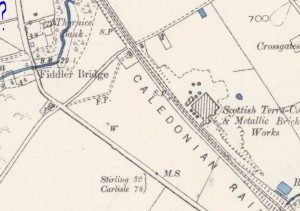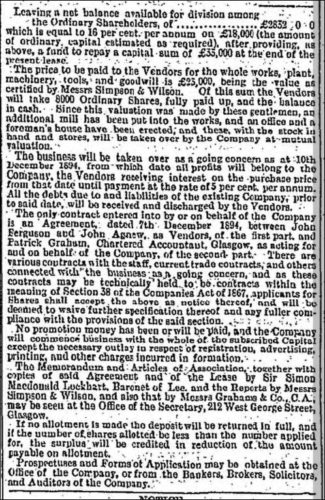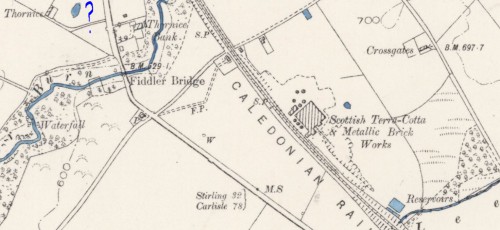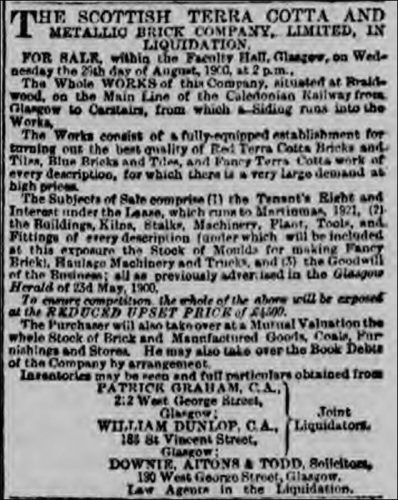Scottish Terra Cotta Co
— 28/07/2024Found by Ian Lewis in the Cleghorn area. This example is not in my possession. Lee Terra Cotta Works, Braidwood, Carluke, Lanarkshire. . . .

Lee Terracotta Works, Braidwood, Carluke, South Lanarkshire aka Scottish Terracotta & Metallic Brick and Tile Works, Braidwood, Carluke, Lanarkshire.
The Lee works faced difficulty at the outset of operations and were seemingly short-lived. They were operated by the Lee Terracotta Company or the Scottish Terracotta Company (sometimes the Scottish Terracotta and Metallic Brick Co). Mark Hurll transported raw material from Carluke, and the Lee Terracotta Works were erected by John Ferguson and John Agnew who also operated the Omoa Fireclay Co.
1891 – 1894 – The 1985 publication ‘A survey of Scottish brickmarks’ suggests that the works may have been started in 1891 by the Lee Terra Cotta Co and operated by them until 1894. (Note – SBH – This is backed up by this invoice – 10/04/1894 – Invoice – Omoa Fire Clay Co. Office 11 West Regent Street, Glasgow. Works by Cleland, by Motherwell. (Note – SBH – No reference to Braidwood under the works heading). Manufacturers of agricultural drain pipes, common and fire bricks. Vitrified pipes, chimney cans, pottery ware &c. Red roofing and ridge tiles, fire clay paving tiles, garden edging, wall cope, terra cotta, ground fire clay &c. Vent linings, fire covers, vases and feeding troughs.)
10/05/1892 – The Glasgow Herald – As everybody knows, bricks are largely used in most buildings, but in Scotland only in partitioning and dividing apartments. Up to a recent period few people in Scotland would have thought of using brick instead of stone in facing their houses: and in such a city as Glasgow, it would have been thought incongruous to erect a brick building of any value or pretension to taste. This was due in great measure to the excellent white freestone we have had in Scotland and to the fact that our clay was not equal to produce such bricks as were manufactured in England. A gradual change is taking place in this respect. White freestone has become nearly exhausted and the red freestone is rapidly taking its place and terracotta is competing with both. A splendid block of buildings was recently erected by the Prudential Insurance Company in Renfield Street of this city, faced with the finest English brick from Ruabon in Wales. In the country, there are springing up a few fine palatial residences, brilliant with the red terracotta brick. And the Fine Art Galleries and the New Conservative Club, both about to be erected in Glasgow are to be built from this terracotta brick. Under these circumstances, it may seem singular that this clay which has been so often sought for and long wanted, has been found and that this terracotta manufacture, which has hitherto been confined to England and Wales, will now be carried on at Braidwood on the Estate of Simon MacDonald Lockhart, Baronet of Lee and the material, it is said, can be produced at a price which will stimulate and encourage the erection of terracotta buildings throughout Scotland. The Omoa Fireclay Company are busy erecting works on the Caledonian Railway near Braidwood, with all the latest machinery improvements and these works will shortly be in operation. (Note – SBH – There is a reference to terracotta manufacture at Braidwood but I am uncertain to which of the Braidwood Brickworks this refers to so I have noted it here to ensure it is not missed).
1894 – c. 1907 – The 1985 publication ‘A survey of Scottish brickmarks’ suggests that the works may have been operated by the Scottish Terra Cotta Co during this period.
Below – 15/12/1894 – The Scotsman – Scottish Terracotta and Metallic Brick Company (Limited). Full prospectus … This company has been formed for the purpose of acquiring as a going concern, the valuable Terracotta and Metallic Brickworks on the Lee Estate near Braidwood in the County of Lanark belonging to Messrs John Ferguson and John Agnew who are the vendors, together with the lease from Sir Simon Macdonald Lockhart, Baronet of Lee of which 17 years have yet to run, of the clay, limestone and coal in certain portions of his Estate of Lee, with the exclusive right to work the same and the whole plant, machinery and goodwill of the business. The discovery on the Lee Estate some time since of clay possessed of the same character and qualities as the best Staffordshire and Ruabon district clays from which the widely known blue and red bricks of these districts and terracotta goods are manufactured has enabled the vendors, after exhaustive investigations and experiments, to produce terracotta bricks and blue metallic bricks and tiles of a quality equal in all respects to the best English made goods of this description …




05/01/1895 – Dundee Advertiser – New company. The Scottish Terracotta and Metallic Brick Company (Limited), Glasgow to carry on the business of dealers in bricks, terracotta goods &c; capital of £35,000 in 15,000 preference shares and £20,000 ordinary shares of £1 each.
19/04/1895 – Glasgow Herald – The Scottish Terracotta and Metallic Brick Company (Limited) have secured the order for supplying terracotta bricks for the new hospital in Ruchill (Glasgow). The amount required will not be much short of 1,000,000 red bricks.
16/11/1895 – Glasgow Herald – Mr William Roberton, 19 Newton Place, Glasgow a director in the Scottish Terracotta and Metallic Brick Company (Limited) has also joined the board of the Cleland Pottery Company (Limited).
1896 – The Lee Terracotta Works (Louis Nerou, Manager) Braidwood Carluke.
Below – 1896 – Scottish Terra Cotta & Metallic Brick Works, Carluke.

11/03/1896 – Dundee Advertiser – The new Prudential buildings in Dundee … The brick used is that supplied by the Scottish Terra Cotta Company Limited, a particularly fine, hard and pretty composition …
26/11/1896 – The Scotsman – New chimney at the Edinburgh Gasworks – The new chimney at the Edinburgh and Leith Gasworks, New Street, which has been in course of construction since November 1895, will be completed tomorrow … The chimney is 250 feet high … At the base, the brickwork consists of fifteen footing courses built solid for a height of four feet in cement mortar with first quality Whitehill composition bricks except in the centre and under the flue openings where fire bricks bedded in fireclay were used … The outside of the chimney is faced with red bricks made by the Scottish Terra-Cotta Company, Braidwood, and this gives it a perfectly uniform and handsome appearance, forming a pleasing contrast with the Prudham stone …
1897 – 1898 – Scottish Terra-Cotta and Metallic Brick Co., Ltd., manufacturers of terra-cotta and blue metallic bricks, station platform tiles, chimney cans, &c. Works, Braidwood, by Carluke, regd.,office, 212 West George St.; Patrick Graham, C.A, secretary.
17/04/1897 – Damage, which is estimated at from £3000 to £4000 has been done by fire at the works of the Terra Cotta and Metallic Brick Company at Braidwood, near Carluke.
17/04/1897 – The Scotsman – About eleven o’clock on Thursday night the engine house and machinery shed at the brickwork of the Scottish Terra-Cotta and Metallic Brick Company (Limited), situated at Braidwood, near Carluke, were discovered to be on fire. Efforts were at once made by the workmen to extinguish the fire, while the Carluke Fire Brigade were sent for, but all the measures taken to extinguish the conflagration were unavailing. The brigade was greatly hampered by the scarcity of water and the insufficient pressure, as it had to be pumped from a dam some distance off. The machinery shed which contained three large crushing rollers, three pan mills, brick machine, steam press, &c, together with the engine-house, oil-house, and joiner shop, were completely gutted, and only the bare walls remain standing. The fire also extended to the smith’s shop but was suppressed there, although a number of tools were wasted. The flames were prevented from catching the drying sheds. The damage cannot be very accurately estimated, but it will very probably amount to £3000. A number of men will be thrown out of work.
Below – 25/11/1898 – Casemine – Hockey V Clydesdale Bank. This case involved John Agnew and whether fraud occurred involving his business dealings and whether the Clydesdale Bank were involved in the fraud.

…

…

May 1899 – The British Clay Worker – Wanted. An experienced yard foreman for red and blue works. Good references are indispensable. Apply Sottish Terra Cotta Co, Braidwood, Carluke. N.B.
Below – 21/05/1900 – The Scotsman – Scottish Terra Cotta & Metallic Brick Company Limited in liquidation.

Below – 23/05/1900 – Glasgow Herald – Scottish Terra Cotta & Metallic Brick Company Limited in liquidation sale £7500.

.

.

11/06/1900 – Glasgow Herald – Scottish Terra Cotta & Metallic Brick Company Limited in a liquidation sale. Reduced to £6000.
Below – 29/08/1900 – Glasgow Herald – Scottish Terra Cotta & Metallic Brick Company Limited in liquidation sale £4500.

Below – 26/09/1900 – The Scotsman – Scottish Terra Cotta & Metallic Brick Company Limited in liquidation sale £3500.

1900 – 1901 – Scottish Terra-Cotta and Metallic Brick Co., Ltd., manufacturers of terra-cotta and blue metallic bricks, station platform tiles, chimney cans, &c. Works, Braidwood, by Carluke, regd.,office, 212 West George St.; Patrick Graham, C. A., secretary.
1901 – Directory of Clayworkers – The Lee Terra Cotta Works, Braidwood, Carluke.
1901 – Records of Shirlaw Allan, Industrial Auctioneers, Hamilton, Scotland. For sale – Sale of stock, brick making machinery and buildings at Scottish Terra-Cotta and Metallic Brick Co., Ltd, Braidwood.
18/05/1901 – Airdrie and Coatbridge Advertiser – Sale – on an early day at the Scottish Terra Cotta Works by Carluke. The residue of stock.
22/06/1901 – The Scotsman – Terra Cotta Clayfield to let. To let for entry on Martinmas first, the Terra Cotta Clayfield on Lee Estate at present held in lease by the Scottish Terra Cotta & Metallic Brick Company Limited. This clayfield is at the side of the Caledonian Railway about half a mile to the South of Braidwood Railway Station and has railway siding accommodation. Particulars may be had from Messrs McGreaths & Stevenson, 208 Vincent Street, Glasgow or D. W. Stewart, factor, Cartland, Lanark and the latter will receive offers up till 1st proximo.
Below – 14/03/1902 – Edinburgh Gazette.

1903 – Scottish Terra Cotta & Metallic Brick Company Limited dissolved.
21/11/1914 – Carluke and Lanark Gazette – The late Mr John Agnew – We regret to record the death of Mr John Agnew, which took place on Sunday morning last at ten minutes to five at Nellfield Lodge, Brentwood. Mr Agnew has been laid aside by illness for some weeks back, and his death was not unexpected to his family and relatives. He was 62 years of age and was a native of Cleland. At an early age, Mr Agnew showed managing abilities and when he was 21 years of age he was given charge of brickworks in Carluke parish. He afterwards acquired an interest in the brickworks at Cleland, which he carried on for several years. Later he became a partner in the Airdrie and Ravenshall Coal Coy. White connected with this company, Mr Agnew became acquainted with the valuable properties of the terra-cotta clay found at Nellfield (Braidwood) and Lee Estate (Lanark). He took a lease of the clay field on Lee Estate and for many years it was worked by the Scottish Terra-cotta and Metallic Brick Coy Ltd, of which Mr Agnew was managing director. Later he became connected with the Nellfield Estates Coy., Ltd. The works of this Coy. are at Braidwood, and it was understood that the industry carried on was the preparation and manufacture of chemical manure, one of the ingredients used being leather parings. Mr Agnew was at one time connected with the carrying on of the Milton Brickwork and the Milton Pit, near Shieldhills. He was also connected with various other ventures. For a short term, he took an interest in public affairs, and was elected as a member of the Carluke Parish Council, and sat as chairman of the Council. In recent years his business ventures had led him into much litigation, which had a depressing effect on him. Some time ago he removed his residence from Carluke to the more secluded quiet of Nellfield Lodge, near Braidwood. The funeral which was a private one took place to Wilton Cemetery on Thursday afternoon. Much sympathy has been expressed for Mrs Agnew and the family in their great less.
Below – 2015 – Study into the historical development of the Clyde and Avon Landscapes.
